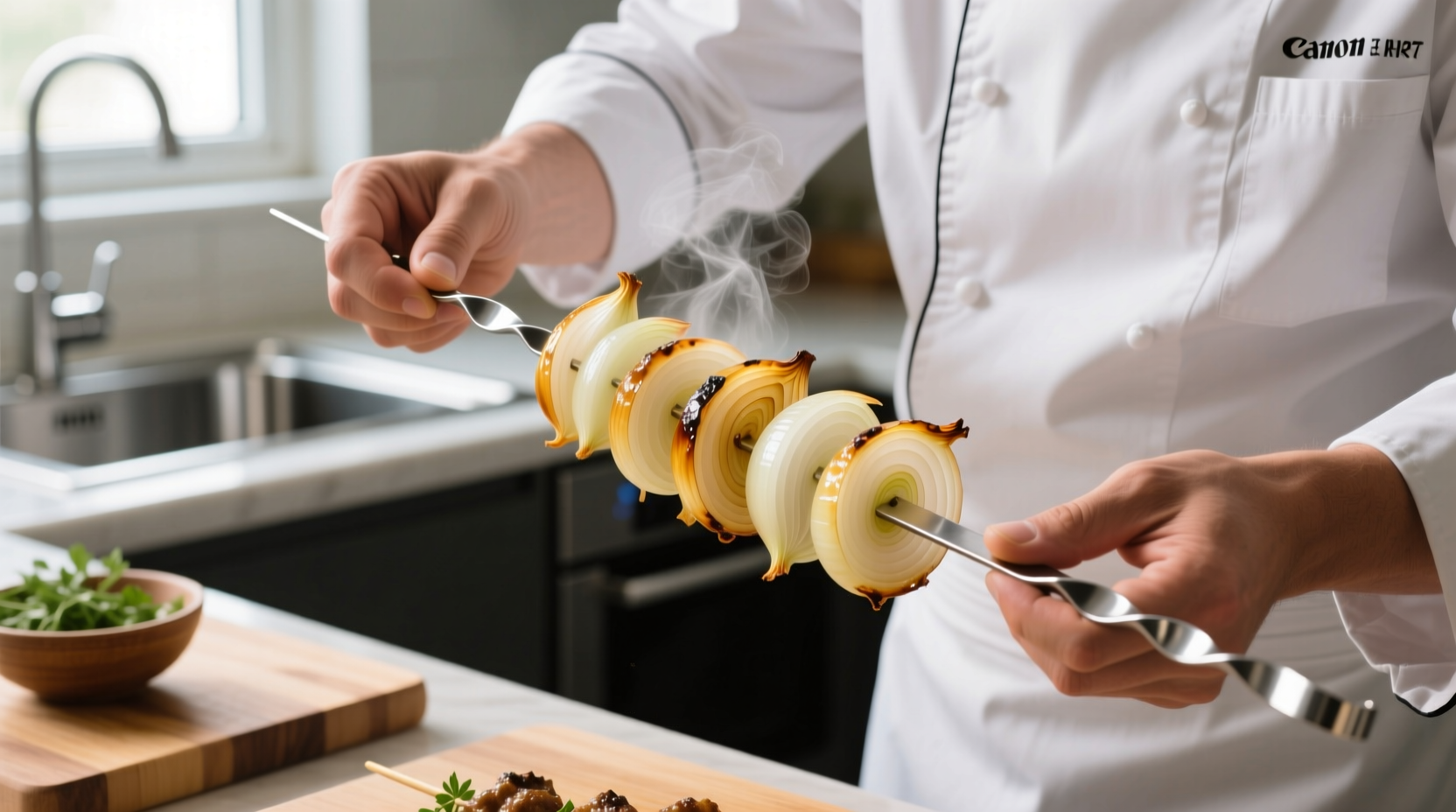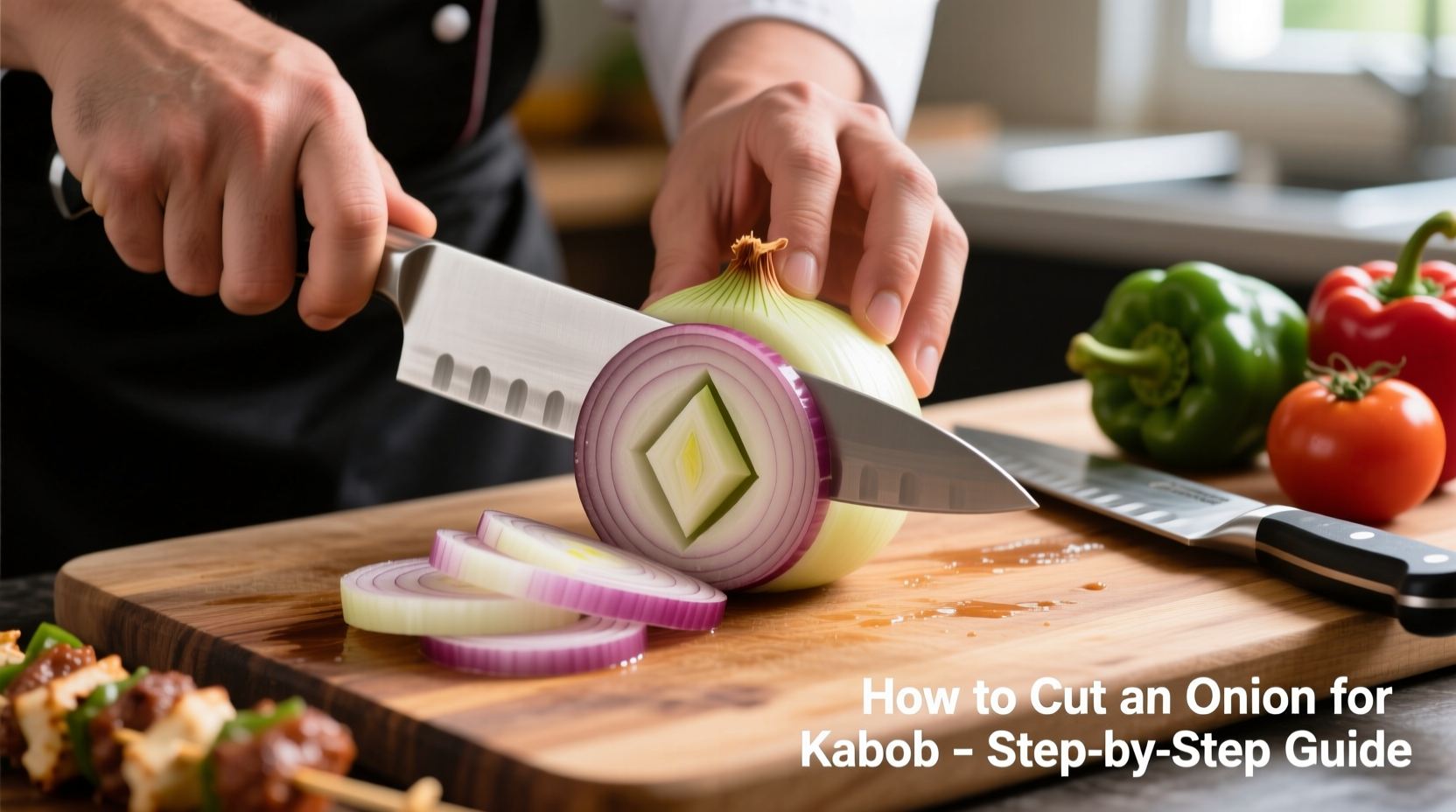For perfect kabobs, cut onions into 1-inch thick wedges that maintain their shape during grilling. Start by slicing off the root and stem ends, peel the onion, cut it in half through the root, then slice each half into 4-6 wedges while keeping the root end intact. This technique ensures onions stay securely on skewers and cook evenly without falling apart.
Nothing ruins a perfectly grilled kabob faster than onions that tumble off the skewer or cook unevenly. As someone who's grilled hundreds of kabobs across backyard barbecues and professional kitchens, I've learned that onion preparation makes all the difference between restaurant-quality results and frustrating kitchen disasters. The right cutting technique transforms onions from a problematic ingredient into the flavorful backbone of your kebabs.
Why Onion Cutting Technique Matters for Kabobs
Unlike regular cooking where diced onions disappear into sauces, kabobs demand structural integrity. Onions that are too small fall through grill grates; pieces that are too large won't cook through before your protein overcooks. The ideal kabob onion must:
- Maintain shape during skewering and grilling
- Cook at the same rate as accompanying proteins
- Provide maximum surface area for flavor development
- Stay securely attached to the skewer
Improperly cut onions lead to uneven cooking, frustrating skewer assembly, and wasted ingredients. The wedge technique solves all these problems while enhancing flavor through controlled caramelization.
Essential Tools for Perfect Kabob Onions
You don't need specialty equipment, but having the right basics makes the process smoother:
- Sharp chef's knife (8-10 inches)
- Stable cutting board
- Metal or soaked wooden skewers
- Small bowl of cold water (optional for tear prevention)
A sharp knife is non-negotiable—dull blades crush onion cells, releasing more irritants and creating ragged cuts that fall apart on the grill. According to the USDA Food Safety and Inspection Service, proper knife maintenance also reduces cross-contamination risks during food preparation.
Step-by-Step: Cutting Onions for Kabobs
Step 1: Prepare Your Onion
Place the onion on your cutting board and slice ¼ inch off both the root and stem ends. This creates stable, flat surfaces while removing the toughest, inedible parts. Peel away the papery outer skin and any damaged outer layers. For tear prevention, chill onions for 30 minutes before cutting or cut under running water—both methods reduce the release of syn-propanethial-S-oxide, the compound that causes eye irritation.
Step 2: Create Stable Halves
Stand the onion upright on one of the flat ends you just created. Carefully slice straight down through the root end to divide the onion into two equal halves. Keep the root end intact—this crucial step maintains the onion's structural integrity during subsequent cuts.
| Cutting Method | Skewer Stability | Cooking Evenness | Flavor Development |
|---|---|---|---|
| 1-inch wedges (root intact) | ★★★★★ | ★★★★☆ | ★★★★☆ |
| Quartered (root removed) | ★★☆☆☆ | ★★★☆☆ | ★★★☆☆ |
| Diced (½ inch) | ★☆☆☆☆ | ★★☆☆☆ | ★★☆☆☆ |
| Large chunks (1½ inch) | ★★★★☆ | ★☆☆☆☆ | ★★☆☆☆ |
Step 3: Cut Perfect Wedges
Place each onion half flat-side down. Starting from the stem end, make angled cuts toward the root end, creating 4-6 wedges per half depending on onion size. Aim for 1-inch thickness at the widest point. The angled cut creates more surface area for caramelization while maintaining structural integrity through the root connection.
This technique works because it follows the onion's natural fiber structure. As Rutgers New Jersey Agricultural Experiment Station explains, cutting with the grain (parallel to fiber direction) rather than across it preserves cell structure, preventing disintegration during cooking.
Step 4: Skewer with Confidence
Thread each wedge onto your skewer through the thickest part near the root end. Alternate with proteins and other vegetables, leaving small gaps between ingredients for even heat circulation. The intact root end acts as an anchor, preventing rotation and maintaining position during flipping.
Pro Tips for Kabob Onion Success
- Size consistency is critical: Match onion wedge size to your protein chunks—larger meats need larger wedges
- Prevent premature cooking: If marinating, add onions last since they absorb flavors quickly
- Grill placement matters: Position onions away from direct flame to prevent burning before proteins cook through
- Don't overcrowd: Leave space between pieces for proper air circulation and even cooking
Common Mistakes to Avoid
Even experienced grillers make these onion preparation errors:
- Removing the root end: This causes wedges to separate into individual layers on the grill
- Uniform straight cuts: Creates pieces that rotate on skewers and cook unevenly
- Too-small pieces: Falls through grill grates or overcooks before proteins are done
- Dry skewering: Thread slightly damp onions for smoother skewer penetration
Contextual Considerations for Different Kabob Styles
The perfect onion cut varies slightly depending on your kabob style and cooking method:
- Middle Eastern shish kebabs: Use red onions cut slightly smaller (¾ inch) for quicker cooking with lamb
- Mediterranean vegetable skewers: Larger wedges (1¼ inch) work better with slower-cooking vegetables
- Indoor grill or broiler: Cut onions slightly thicker since radiant heat cooks faster than outdoor grills
- Delicate proteins like fish: Use shallots or sweet onions cut into smaller wedges that cook faster
Remember that cooking environment affects results—outdoor grills typically require slightly larger cuts than indoor methods due to more intense, direct heat. This contextual adaptation is essential for consistent results across different cooking scenarios.

Storing Pre-Cut Onions for Later Use
If preparing ahead, store cut onions in an airtight container in the refrigerator for up to 24 hours. Place a damp paper towel in the container to maintain moisture without making onions soggy. Never store cut onions with proteins—onions' strong flavor can transfer and alter meat taste. According to food safety guidelines from the USDA Food Safety and Inspection Service, keeping vegetables and meats separate prevents cross-contamination and preserves optimal flavor profiles.
Mastering the Art of Kabob Assembly
Once your onions are properly cut, assembly technique becomes crucial. Start and end each skewer with sturdy ingredients like bell peppers or potatoes to create anchors. Alternate between dense and delicate items—place onions between protein chunks to create natural barriers that prevent sticking. Leave ½ inch of skewer exposed at both ends for safe handling. This strategic arrangement ensures even cooking and prevents ingredients from spinning when flipped.
Final Thoughts on Perfect Kabob Onions
The secret to restaurant-quality kabobs lies in respecting each ingredient's unique properties. Properly cut onions contribute sweetness through controlled caramelization, provide textural contrast, and help distribute heat evenly across the skewer. By maintaining the root connection and cutting at the right angle, you create onion pieces that stay securely in place while developing complex flavors during grilling. This technique works equally well for all onion varieties—from sharp red onions in Mediterranean kebabs to sweet Vidalias in American-style skewers.











 浙公网安备
33010002000092号
浙公网安备
33010002000092号 浙B2-20120091-4
浙B2-20120091-4